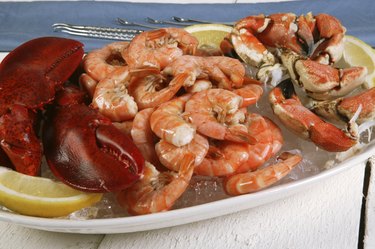
For cooks and scientists alike, the differences between closely related species in the natural world prove endlessly fascinating. For example, apples, pears, quinces and rose hips, all close cousins, differ in culinary properties. The same holds true for crustaceans, which include several of the most cherished forms of seafood. Biologically shrimp, crabs and lobsters are close kin, but their physical differences affect how they're cooked and used.
The Decapods
Video of the Day
Like terrestrial insects, aquatic crustaceans are invertebrates whose muscles are supported by an armored exoskeleton, rather than an internal framework of bone and cartilage. The outer shell, segmented and jointed, allows the creatures to move, swim, feed and evade or combat predators as needed. Crabs, lobsters and shrimp are "decapods," meaning they have 10 limbs, structured as legs or claws. Culinarily, crustaceans owe their popularity to a biological quirk. Their flesh contains large quantities of free amino acids -- not bound up in full-chain proteins -- as well as sugars. This gives them rich, sweet, savory, complex flavors that are difficult to reproduce in other foods.
Video of the Day
About Shrimp
Shrimp represent one of the widest crustacean families, from the microscopic "krill" that nourish filter-feeding whales to jumbo prawns weighing several ounces each. Structurally, they're very similar to clawless lobsters, with the plump, muscular tail accounting for most of their body weight. Shrimp shells are relatively soft and easy to remove, along with the feathery shells. In places where shrimp are eaten fresh from the water, the heads are left on, and the fatty, liver-like hippocampus -- comparable to the green "tomalley" in a lobster -- is sucked from the heads as a delicacy. Unfortunately, it's also highly perishable, so shrimp in the United States are usually sold with the heads removed to improve their storage life.
Consider the Lobster
Although similar in structure to shrimp, the lobster's harder, spiky shell -- and formidable claws, in the case of the American lobster -- make it altogether more intimidating. As with, shrimp most of the meat is concentrated in a lobster's tail, and clawless varieties are usually sold in tail-only form. The claws of the American lobster, the species landed in Maine and other North Atlantic fisheries, also contain large morsels of rich, delicate meat. In large specimens, even the legs and the compartmented thorax, comparable to the hips of a land animal, contain usable quantities of meat. Commercial canneries are adept at extracting these sweet morsels.
About Crabs
While shrimp and lobsters share a strong family resemblance, crabs take the same basic elements -- armored body, multiple legs -- and alter them drastically. The tail is reduced to a vestigial flap or "apron" over the crab's belly, and the broad, flat design of the shell is radically different from the lobster's roughly cylindrical shape. Some, such as Florida's stone crab, are primarily valued for their meaty claws. Alaskan king crab, on the other hand, is harvested for its meaty legs. Others, including the Dungeness and blue crab, boast leg, claw and body meat from the thorax. Blue crabs are especially cherished after they molt, when their shells are soft enough to eat whole.
Preparation and Use
Preparation methods for all three overlap to an extent, but each has its strengths. Shrimp, because they're smallest and self-contained, are arguably the most versatile. They're appropriate for almost any cooking method except slow braising, and can be steamed, broiled, deep-fried, sauteed or grilled with equal success. Lobsters are often simply steamed or boiled, but can also be split and broiled or grilled. Cooked lobster can be served warm or cold, or incorporated into salads, omelets, ravioli, and many other dishes. Meaty crab varieties such as Dungeness can be steamed or simmered whole, or with their upper carapace removed so flavors can infuse their flesh. Claws and legs are typically sold cooked and ready to eat, either reheated or cold.